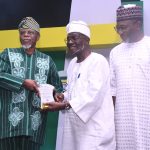By Olakunle Yusuf
Leadership is regarded as essential in life, in society and in organisations. It is for this reason that this article explains leadership, in particular citizens/ employees’ perceptions of leadership, with regard to social exchange and institutional (behavioural) isomorphism theories, acknowledging the contextual differences between the private and the public sectors.
The purpose of the article is to compare the perceptions of employees from organisations in the private and the public sector based on 12 independent cross-sectional studies (conducted over six months).
Eight leadership styles were examined, namely, authentic, empowering, ethical, servant, transformational, transactional, and ubuntu or Afrocentric leadership, and leader–member exchange. One of the studies included a measurement of organisational culture, to be brought in relation with leadership. The results of this study indicate that the employees in the private sector have a significantly better perception of leadership compared to those in the public sector (except for transactional leadership). It was further found that the two sectors differ significantly with regard to the perceived cultures, and that the cultural types are related to the perception of leadership.
Perception is a powerful force that can shape the course of political realities. The way individuals perceive political events, leaders, and ideologies can greatly affect the outcomes of elections, policy decisions, and the overall direction of a nation. In this article, we will explore the impact of perception on political outcomes, the influence of perception on political decision-making, and the correlation between perception and political outcome. We will also examine how perception can shape political narratives, ideologies, and power dynamics. By understanding these dynamics, we can gain insights into how perception can influence political views and impact political legitimacy.
Public perception plays a crucial role in determining the outcome of political events. When voters are swayed by certain perceptions or narratives surrounding political candidates or parties, it can heavily influence their voting decisions. For example, a candidate who is viewed as trustworthy and competent is more likely to garner support from the electorate than one who is perceived as untrustworthy or inexperienced.
Furthermore, perception can also shape how political parties frame their policies and messages. Parties often tailor their communication strategies to appeal to the perceptions and interests of specific voter groups, aiming to create positive associations and gain support. Understanding and harnessing the power of perception is thus vital for political parties seeking to win elections and shape political realities.
Studies have consistently shown a correlation between public perception and political outcomes. Research conducted on various elections around the world has indicated that the way voters perceive candidates and parties strongly influences electoral results. Candidates who effectively manage their public image and shape positive perceptions among voters are more likely to emerge as winners.
Perception not only influences individual voting decisions but also shapes the overall political narrative. Media outlets, interest groups, and political leaders continuously seek to influence public opinion by framing political events and issues in a particular light. By shaping perceptions through strategic communication and messaging, these actors can control the narrative and influence the direction of political debates.
For example, by emphasizing certain aspects of a policy proposal or selectively highlighting certain statistics, policymakers can sway public opinion in their favor. They understand that public perception ultimately determines the success or failure of their policy initiatives, making the perception management an integral part of their decision-making process.
Perception not only impacts individual voting decisions and policy debates but also plays a key role in shaping political ideologies. People’s perception of events, issues, and leaders can greatly influence their political beliefs and affiliations. This can be seen in how various political ideologies are grounded in different perceptions of society and the role of government.
For example, individuals who perceive society as inherently unequal may lean towards ideologies that advocate for greater social and economic equality. On the other hand, those who perceive society as meritocratic may align with ideologies that emphasize personal responsibility and limited government intervention.
Understanding the underlying perceptions that shape political ideologies can provide insights into why certain beliefs persist and how they can be either reinforced or challenged.
This writer research largely finds that politicians’ public opinion perceptions are not particularly accurate – certainly no more so than the accuracy exhibited by non-elites – and concludes that politicians can hardly be considered the true public opinion experts they are frequently expected to be. Politicians’ estimates of popular support for specific policy proposals are often erroneous, their estimates are biased in a right-wing direction, and often they even situate the majority on the wrong side of the debate.
Yet, policy responsiveness probably does not depend on all politicians’ perceptual accuracy equally. In fact, it stands to reason that the perceptions of some politicians matter more than those of others. Leading politicians have more influence on policy decisions than backbenchers do; politicians in the government have a direct impact on the policies in their ministerial portfolio but also, more generally, on all policy decisions taken by the cabinet. In many countries, party leaders are responsible for selecting policy issues on the electoral agenda, negotiating (governmental) coalition agreements, drafting policy solutions, and ensuring party unity during parliamentary votes; parliamentary leaders control the parliamentary agenda and make sure that policy measures are voted (or not). This state of affairs, should provide an important qualification to the link between perceptual accuracy and representation even if the majority of politicians fail at accurately estimating what the public wants – which extant evidence substantiates – worry that these erroneous perceptions might push policies away from popular preferences could be mitigated insofar as politicians in leadership positions do a better job. If leading politicians had a better nose for public opinion, concerns about low mean perceptual accuracy levels in democracies might be overstated as those elected officials who have the most control over the direction of policymaking do have the necessary capacity to develop responsive policies insofar as they are interested in doing so.
Three findings stand out. First, when tested directly, leaders are hardly better at estimating public opinion than regular parliamentarians. Leveraging different indicators of leadership (formal leadership and seniority) and measuring different types of perceptual accuracy (estimating general public opinion and party electorate opinion) in different ways (majority and percentage point inaccuracy), we find no convincing evidence that leaders do a better job in rating public opinion. Leaders make errors as frequently as their common peers, and their perception errors are almost equally large.
Second, we supply evidence that politicians themselves do consider politicians in leadership positions as superior readers of public opinion. Third, and in contrast to politicians’ own expectations, as a group, those politicians put forward by their fellow representatives as the best public opinion raters do not perform any better compared to the rest of our sample. In sum, political leaders seem to have no special talent or skill for accurately reading public opinion, nor does such a skill develop over time or through occupying more senior positions.
Olakunle Yusuf, Lead Consultant, Above Media.












